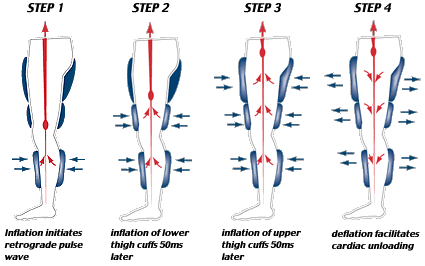Patients who have persistent anginal symptoms, who have exhausted the standard treatments for revascularization and remain severely restricted. Enhanced External Counter Pulsation (EECP) may stimulate the openings or formation of collaterals (small branches of blood vessels) to create a natural bypass around narrowed or blocked arteries.
The basic principle of EECP treatment involves increasing the amount of blood returning to the heart, which helps supply more oxygen to its starved areas. With more oxygen available, the heart can function much more efficiently and therefore reduce chest pain.
It’s a non-invasive treatment to lower the number and intensity of angina episodes.
Treatment is administered through three pairs of external inflatable cuffs that are applied around the lower legs, upper legs and buttocks. These cuffs continuously inflate and deflate between the resting period of the heartbeat and increase blood returned to the heart.

Who Is Eligible for EECP Treatment?
Individuals are eligible for treatment if they have:
- Had coronary artery bypass (CABG) or stents placed in the coronary arteries with ongoing angina.
- Had no prior bypass or stenting but continue to suffer from angina
Who Should Not Seek EECP Treatment?
Patients who should not undergo EECP include those with:
Hypertrophic cardiomyopathy
Congenital heart disease
Valvular disease
Enlarged heart
Pacemaker
Hemorrhage
Atrial fibrillation (Afib)
Pulmonary hypertension
Clot in their body
Peripheral artery disease (PAD), also called peripheral vascular disease (PVD)
Severe elevated blood pressure
Heart rate greater than 120 beats per minute

Enhanced external counterpulsation (EECP) has been approved by the United States Food and Drug Administration (FDA) for management of refractory angina (Class IIb). EECP uses three sets of pneumatic cuffs that sequentially contract during diastole, increasing aortic diastolic pressure, augmenting coronary blood flow and central venous return. EECP improves anginal symptoms and exercise tolerance, and reduces nitroglycerin use in patients with chronic, stable angina. EECP has also been shown to be safe and beneficial in patients with symptomatic stable congestive heart failure. It has been postulated that cardiac benefits of EECP are mediated though vascular endothelial growth factor (VEGF) and nitric oxide mediated vasodilatation and angiogenesis. In June 2002, the FDA also approved EECP therapy for heart failure patients.
The idea for EECP stemmed from the development of the intra-aortic balloon pump (IABP). IABP resulted in increasing the amount of blood that can get pumped out of the heart by inflating a balloon in the aorta between each heartbeat. Opening up the aorta allows more blood flow and therefore decreases how hard the heart has to work. This same theory is applied to EECP but is taken one step further. EECP Increases the amount of blood going back to the heart, providing more blood for the heart to work with. This also decreases how hard the heart has to work but on a much greater scale, especially for people with damaged heart tissue.
EECP treatment Process
- EECP treatment gently but firmly compresses the blood vessels in the lower limbs to increase blood flow to your heart. Each wave of pressure is electronically timed to the heartbeat, so that the increased blood flow is delivered to your heart at the precise moment it is relaxing. When the heart pumps again, pressure is released instantaneously. This lowers resistance in the blood vessels in the legs so that blood may be pumped more easily from your heart.
- EECP may encourage blood vessels to open small channels that become extra branches. These channels or collaterals may eventually become “natural bypass” vessels to provide blood flow to heart muscle. This contributes to the relief of angina symptoms.
Patients who are accepted for treatment must undergo 35 hours of EECP therapy. Treatment is administered 1-2 hours a day, five days a week, for 7 weeks.Published studies conducted at numerous medical centers have demonstrated benefits for most patients including:
- Less need for anti-anginal medication
- Decrease in symptoms of angina
- Increased ability to do activities without onset of symptoms
- Ability to return to enjoyable activities
ECP and EECP Companies
ACS Logo
Applied Cardiac Systems Inc. (ACS)
CardioMedics
Cardiomedics Inc
Renew
ScootCare
Scottcare Corporation
VasoMedical
Vasomedical Inc.
globe 2
